Fair Value Measurement, GFC, and Accounting Standards Analysis
VerifiedAdded on 2020/03/16
|9
|2151
|34
Essay
AI Summary
This essay critically examines the role of fair value measurement in the Global Financial Crisis (GFC). It argues that fair value accounting was used as a scapegoat, while other factors like regulatory and political issues played a more significant role. The essay explores the initiatives taken by the International Accounting Standards Board (IASB) to address the crisis, including harmonizing accounting standards and clarifying fair value measurement in illiquid markets. It also analyzes the amendments to IAS 39 and IFRS 7 and their impact on financial reporting transparency. The essay further discusses the influence of IASB on the Australian Accounting Standards Board (AASB), highlighting the adoption of IASB guidelines to ensure consistent financial reporting and enhance investor confidence. The conclusion emphasizes that financial illiteracy and lack of understanding of fair value accounting contributed to the crisis. The essay provides an in-depth analysis of the issues, standards, and regulatory responses related to fair value accounting and the GFC.
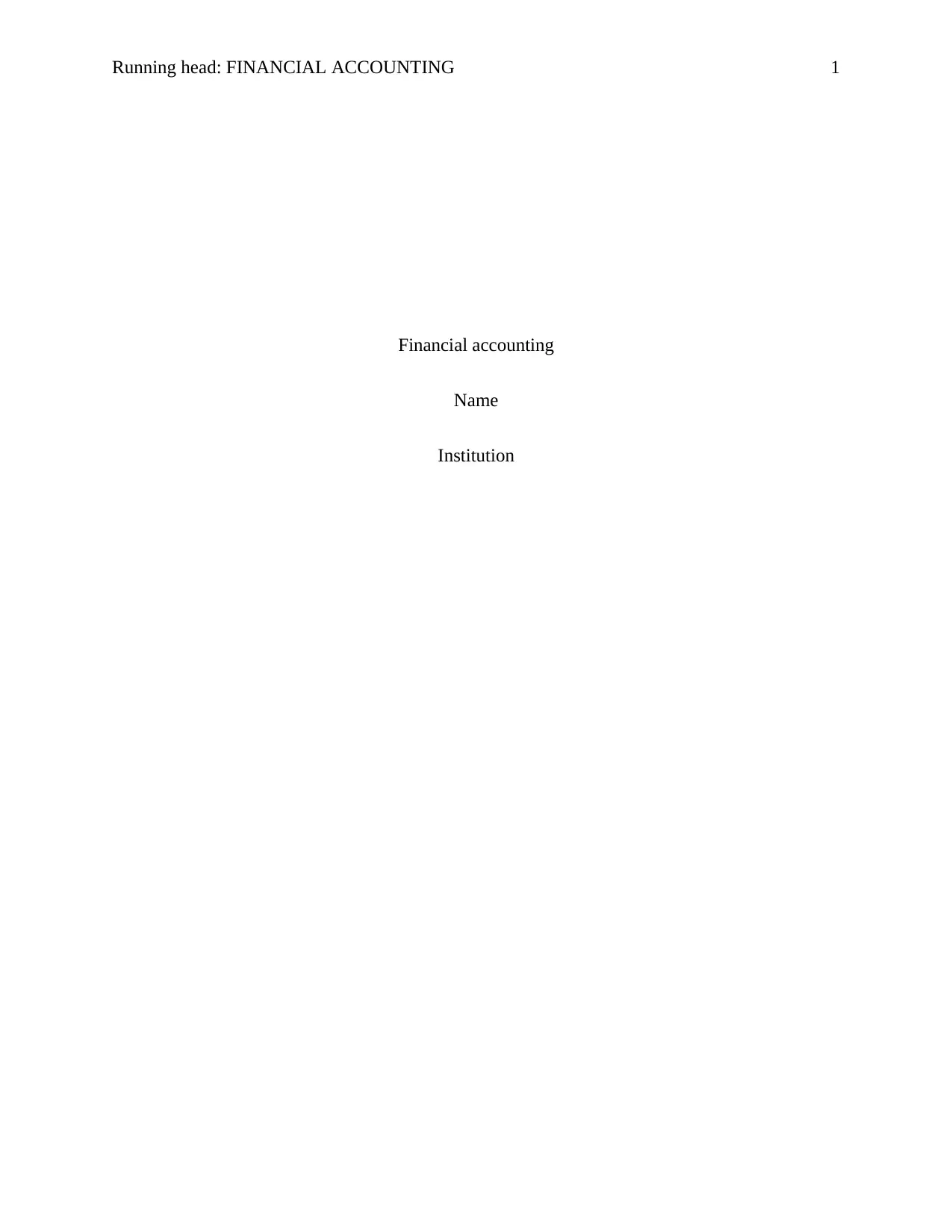
Running head: FINANCIAL ACCOUNTING 1
Financial accounting
Name
Institution
Financial accounting
Name
Institution
Paraphrase This Document
Need a fresh take? Get an instant paraphrase of this document with our AI Paraphraser
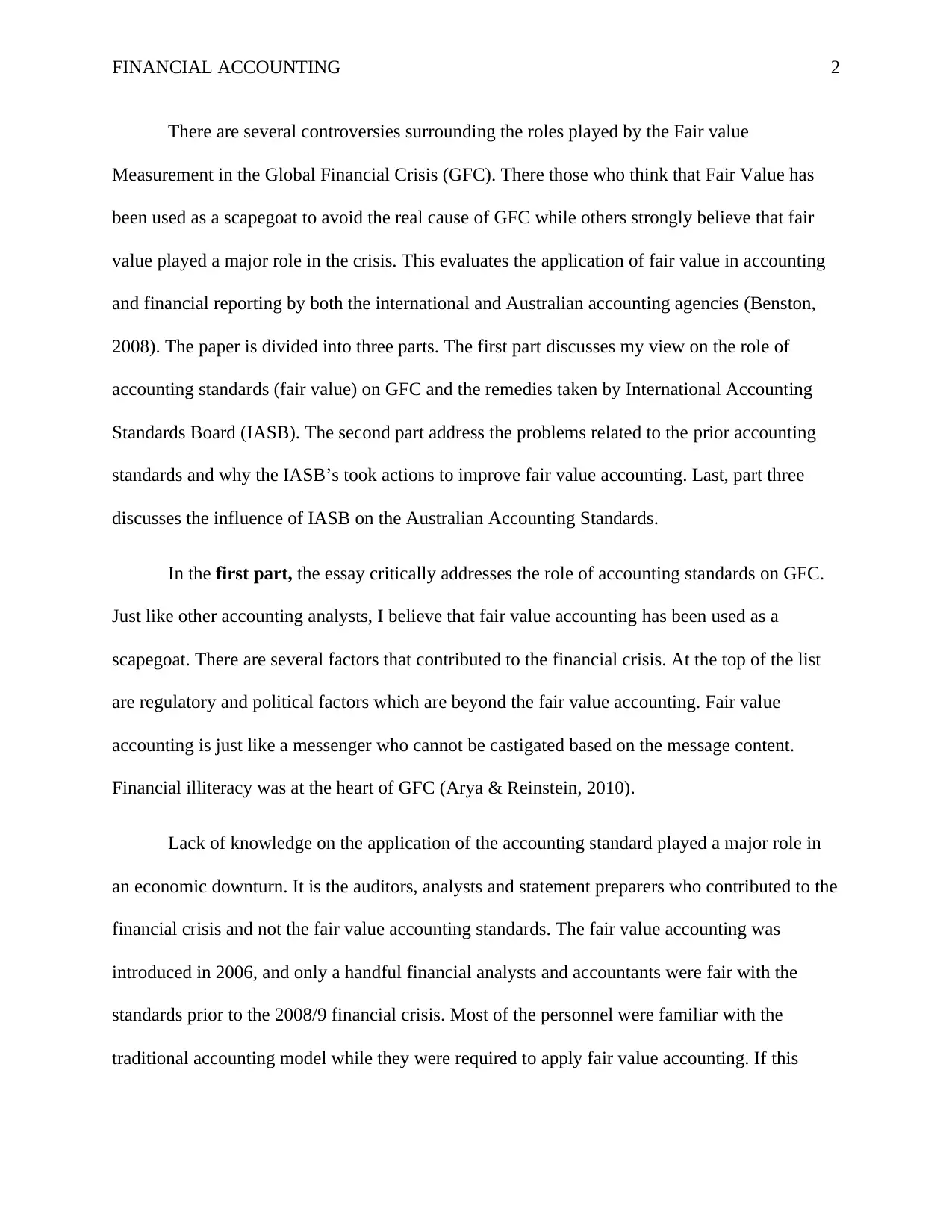
FINANCIAL ACCOUNTING 2
There are several controversies surrounding the roles played by the Fair value
Measurement in the Global Financial Crisis (GFC). There those who think that Fair Value has
been used as a scapegoat to avoid the real cause of GFC while others strongly believe that fair
value played a major role in the crisis. This evaluates the application of fair value in accounting
and financial reporting by both the international and Australian accounting agencies (Benston,
2008). The paper is divided into three parts. The first part discusses my view on the role of
accounting standards (fair value) on GFC and the remedies taken by International Accounting
Standards Board (IASB). The second part address the problems related to the prior accounting
standards and why the IASB’s took actions to improve fair value accounting. Last, part three
discusses the influence of IASB on the Australian Accounting Standards.
In the first part, the essay critically addresses the role of accounting standards on GFC.
Just like other accounting analysts, I believe that fair value accounting has been used as a
scapegoat. There are several factors that contributed to the financial crisis. At the top of the list
are regulatory and political factors which are beyond the fair value accounting. Fair value
accounting is just like a messenger who cannot be castigated based on the message content.
Financial illiteracy was at the heart of GFC (Arya & Reinstein, 2010).
Lack of knowledge on the application of the accounting standard played a major role in
an economic downturn. It is the auditors, analysts and statement preparers who contributed to the
financial crisis and not the fair value accounting standards. The fair value accounting was
introduced in 2006, and only a handful financial analysts and accountants were fair with the
standards prior to the 2008/9 financial crisis. Most of the personnel were familiar with the
traditional accounting model while they were required to apply fair value accounting. If this
There are several controversies surrounding the roles played by the Fair value
Measurement in the Global Financial Crisis (GFC). There those who think that Fair Value has
been used as a scapegoat to avoid the real cause of GFC while others strongly believe that fair
value played a major role in the crisis. This evaluates the application of fair value in accounting
and financial reporting by both the international and Australian accounting agencies (Benston,
2008). The paper is divided into three parts. The first part discusses my view on the role of
accounting standards (fair value) on GFC and the remedies taken by International Accounting
Standards Board (IASB). The second part address the problems related to the prior accounting
standards and why the IASB’s took actions to improve fair value accounting. Last, part three
discusses the influence of IASB on the Australian Accounting Standards.
In the first part, the essay critically addresses the role of accounting standards on GFC.
Just like other accounting analysts, I believe that fair value accounting has been used as a
scapegoat. There are several factors that contributed to the financial crisis. At the top of the list
are regulatory and political factors which are beyond the fair value accounting. Fair value
accounting is just like a messenger who cannot be castigated based on the message content.
Financial illiteracy was at the heart of GFC (Arya & Reinstein, 2010).
Lack of knowledge on the application of the accounting standard played a major role in
an economic downturn. It is the auditors, analysts and statement preparers who contributed to the
financial crisis and not the fair value accounting standards. The fair value accounting was
introduced in 2006, and only a handful financial analysts and accountants were fair with the
standards prior to the 2008/9 financial crisis. Most of the personnel were familiar with the
traditional accounting model while they were required to apply fair value accounting. If this
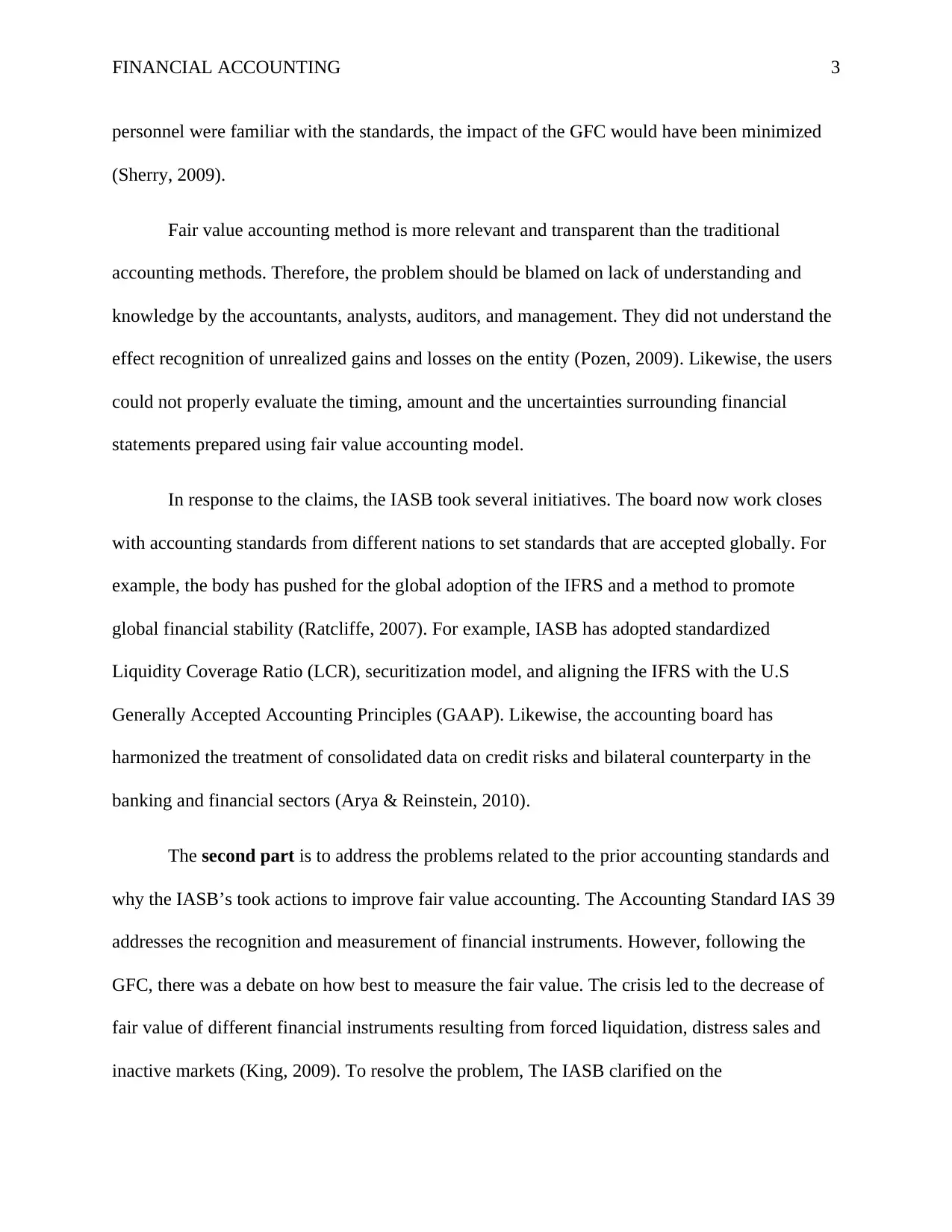
FINANCIAL ACCOUNTING 3
personnel were familiar with the standards, the impact of the GFC would have been minimized
(Sherry, 2009).
Fair value accounting method is more relevant and transparent than the traditional
accounting methods. Therefore, the problem should be blamed on lack of understanding and
knowledge by the accountants, analysts, auditors, and management. They did not understand the
effect recognition of unrealized gains and losses on the entity (Pozen, 2009). Likewise, the users
could not properly evaluate the timing, amount and the uncertainties surrounding financial
statements prepared using fair value accounting model.
In response to the claims, the IASB took several initiatives. The board now work closes
with accounting standards from different nations to set standards that are accepted globally. For
example, the body has pushed for the global adoption of the IFRS and a method to promote
global financial stability (Ratcliffe, 2007). For example, IASB has adopted standardized
Liquidity Coverage Ratio (LCR), securitization model, and aligning the IFRS with the U.S
Generally Accepted Accounting Principles (GAAP). Likewise, the accounting board has
harmonized the treatment of consolidated data on credit risks and bilateral counterparty in the
banking and financial sectors (Arya & Reinstein, 2010).
The second part is to address the problems related to the prior accounting standards and
why the IASB’s took actions to improve fair value accounting. The Accounting Standard IAS 39
addresses the recognition and measurement of financial instruments. However, following the
GFC, there was a debate on how best to measure the fair value. The crisis led to the decrease of
fair value of different financial instruments resulting from forced liquidation, distress sales and
inactive markets (King, 2009). To resolve the problem, The IASB clarified on the
personnel were familiar with the standards, the impact of the GFC would have been minimized
(Sherry, 2009).
Fair value accounting method is more relevant and transparent than the traditional
accounting methods. Therefore, the problem should be blamed on lack of understanding and
knowledge by the accountants, analysts, auditors, and management. They did not understand the
effect recognition of unrealized gains and losses on the entity (Pozen, 2009). Likewise, the users
could not properly evaluate the timing, amount and the uncertainties surrounding financial
statements prepared using fair value accounting model.
In response to the claims, the IASB took several initiatives. The board now work closes
with accounting standards from different nations to set standards that are accepted globally. For
example, the body has pushed for the global adoption of the IFRS and a method to promote
global financial stability (Ratcliffe, 2007). For example, IASB has adopted standardized
Liquidity Coverage Ratio (LCR), securitization model, and aligning the IFRS with the U.S
Generally Accepted Accounting Principles (GAAP). Likewise, the accounting board has
harmonized the treatment of consolidated data on credit risks and bilateral counterparty in the
banking and financial sectors (Arya & Reinstein, 2010).
The second part is to address the problems related to the prior accounting standards and
why the IASB’s took actions to improve fair value accounting. The Accounting Standard IAS 39
addresses the recognition and measurement of financial instruments. However, following the
GFC, there was a debate on how best to measure the fair value. The crisis led to the decrease of
fair value of different financial instruments resulting from forced liquidation, distress sales and
inactive markets (King, 2009). To resolve the problem, The IASB clarified on the
⊘ This is a preview!⊘
Do you want full access?
Subscribe today to unlock all pages.

Trusted by 1+ million students worldwide
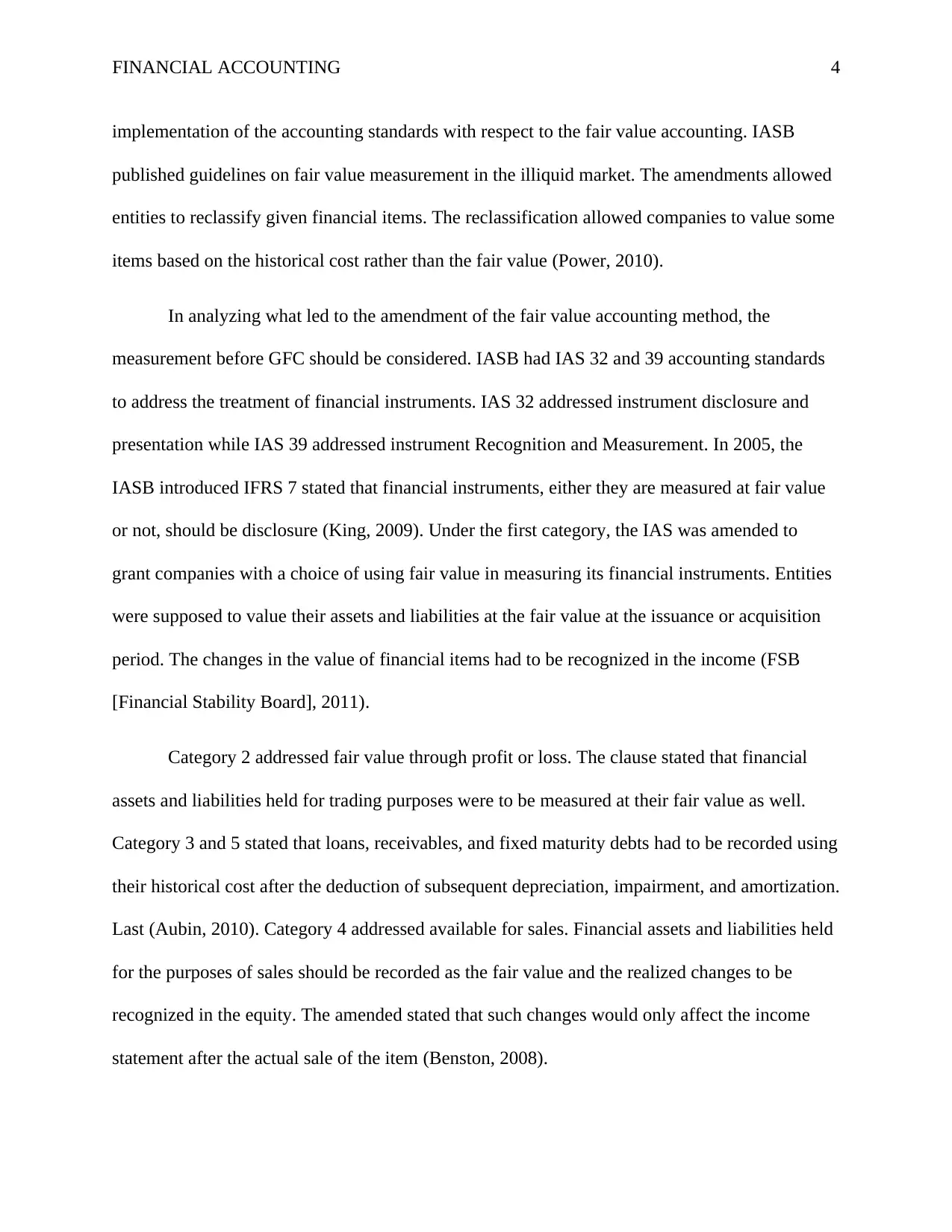
FINANCIAL ACCOUNTING 4
implementation of the accounting standards with respect to the fair value accounting. IASB
published guidelines on fair value measurement in the illiquid market. The amendments allowed
entities to reclassify given financial items. The reclassification allowed companies to value some
items based on the historical cost rather than the fair value (Power, 2010).
In analyzing what led to the amendment of the fair value accounting method, the
measurement before GFC should be considered. IASB had IAS 32 and 39 accounting standards
to address the treatment of financial instruments. IAS 32 addressed instrument disclosure and
presentation while IAS 39 addressed instrument Recognition and Measurement. In 2005, the
IASB introduced IFRS 7 stated that financial instruments, either they are measured at fair value
or not, should be disclosure (King, 2009). Under the first category, the IAS was amended to
grant companies with a choice of using fair value in measuring its financial instruments. Entities
were supposed to value their assets and liabilities at the fair value at the issuance or acquisition
period. The changes in the value of financial items had to be recognized in the income (FSB
[Financial Stability Board], 2011).
Category 2 addressed fair value through profit or loss. The clause stated that financial
assets and liabilities held for trading purposes were to be measured at their fair value as well.
Category 3 and 5 stated that loans, receivables, and fixed maturity debts had to be recorded using
their historical cost after the deduction of subsequent depreciation, impairment, and amortization.
Last (Aubin, 2010). Category 4 addressed available for sales. Financial assets and liabilities held
for the purposes of sales should be recorded as the fair value and the realized changes to be
recognized in the equity. The amended stated that such changes would only affect the income
statement after the actual sale of the item (Benston, 2008).
implementation of the accounting standards with respect to the fair value accounting. IASB
published guidelines on fair value measurement in the illiquid market. The amendments allowed
entities to reclassify given financial items. The reclassification allowed companies to value some
items based on the historical cost rather than the fair value (Power, 2010).
In analyzing what led to the amendment of the fair value accounting method, the
measurement before GFC should be considered. IASB had IAS 32 and 39 accounting standards
to address the treatment of financial instruments. IAS 32 addressed instrument disclosure and
presentation while IAS 39 addressed instrument Recognition and Measurement. In 2005, the
IASB introduced IFRS 7 stated that financial instruments, either they are measured at fair value
or not, should be disclosure (King, 2009). Under the first category, the IAS was amended to
grant companies with a choice of using fair value in measuring its financial instruments. Entities
were supposed to value their assets and liabilities at the fair value at the issuance or acquisition
period. The changes in the value of financial items had to be recognized in the income (FSB
[Financial Stability Board], 2011).
Category 2 addressed fair value through profit or loss. The clause stated that financial
assets and liabilities held for trading purposes were to be measured at their fair value as well.
Category 3 and 5 stated that loans, receivables, and fixed maturity debts had to be recorded using
their historical cost after the deduction of subsequent depreciation, impairment, and amortization.
Last (Aubin, 2010). Category 4 addressed available for sales. Financial assets and liabilities held
for the purposes of sales should be recorded as the fair value and the realized changes to be
recognized in the equity. The amended stated that such changes would only affect the income
statement after the actual sale of the item (Benston, 2008).
Paraphrase This Document
Need a fresh take? Get an instant paraphrase of this document with our AI Paraphraser
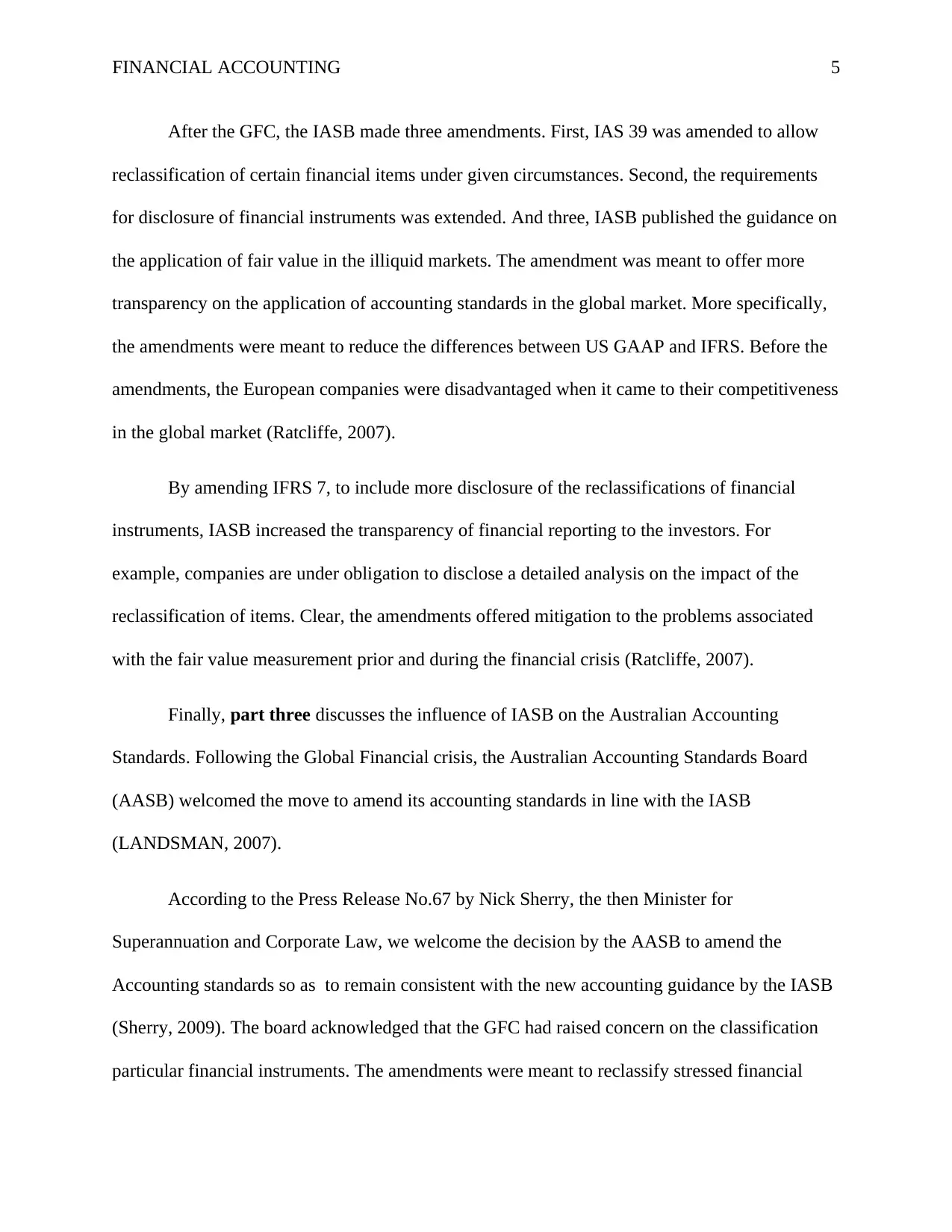
FINANCIAL ACCOUNTING 5
After the GFC, the IASB made three amendments. First, IAS 39 was amended to allow
reclassification of certain financial items under given circumstances. Second, the requirements
for disclosure of financial instruments was extended. And three, IASB published the guidance on
the application of fair value in the illiquid markets. The amendment was meant to offer more
transparency on the application of accounting standards in the global market. More specifically,
the amendments were meant to reduce the differences between US GAAP and IFRS. Before the
amendments, the European companies were disadvantaged when it came to their competitiveness
in the global market (Ratcliffe, 2007).
By amending IFRS 7, to include more disclosure of the reclassifications of financial
instruments, IASB increased the transparency of financial reporting to the investors. For
example, companies are under obligation to disclose a detailed analysis on the impact of the
reclassification of items. Clear, the amendments offered mitigation to the problems associated
with the fair value measurement prior and during the financial crisis (Ratcliffe, 2007).
Finally, part three discusses the influence of IASB on the Australian Accounting
Standards. Following the Global Financial crisis, the Australian Accounting Standards Board
(AASB) welcomed the move to amend its accounting standards in line with the IASB
(LANDSMAN, 2007).
According to the Press Release No.67 by Nick Sherry, the then Minister for
Superannuation and Corporate Law, we welcome the decision by the AASB to amend the
Accounting standards so as to remain consistent with the new accounting guidance by the IASB
(Sherry, 2009). The board acknowledged that the GFC had raised concern on the classification
particular financial instruments. The amendments were meant to reclassify stressed financial
After the GFC, the IASB made three amendments. First, IAS 39 was amended to allow
reclassification of certain financial items under given circumstances. Second, the requirements
for disclosure of financial instruments was extended. And three, IASB published the guidance on
the application of fair value in the illiquid markets. The amendment was meant to offer more
transparency on the application of accounting standards in the global market. More specifically,
the amendments were meant to reduce the differences between US GAAP and IFRS. Before the
amendments, the European companies were disadvantaged when it came to their competitiveness
in the global market (Ratcliffe, 2007).
By amending IFRS 7, to include more disclosure of the reclassifications of financial
instruments, IASB increased the transparency of financial reporting to the investors. For
example, companies are under obligation to disclose a detailed analysis on the impact of the
reclassification of items. Clear, the amendments offered mitigation to the problems associated
with the fair value measurement prior and during the financial crisis (Ratcliffe, 2007).
Finally, part three discusses the influence of IASB on the Australian Accounting
Standards. Following the Global Financial crisis, the Australian Accounting Standards Board
(AASB) welcomed the move to amend its accounting standards in line with the IASB
(LANDSMAN, 2007).
According to the Press Release No.67 by Nick Sherry, the then Minister for
Superannuation and Corporate Law, we welcome the decision by the AASB to amend the
Accounting standards so as to remain consistent with the new accounting guidance by the IASB
(Sherry, 2009). The board acknowledged that the GFC had raised concern on the classification
particular financial instruments. The amendments were meant to reclassify stressed financial
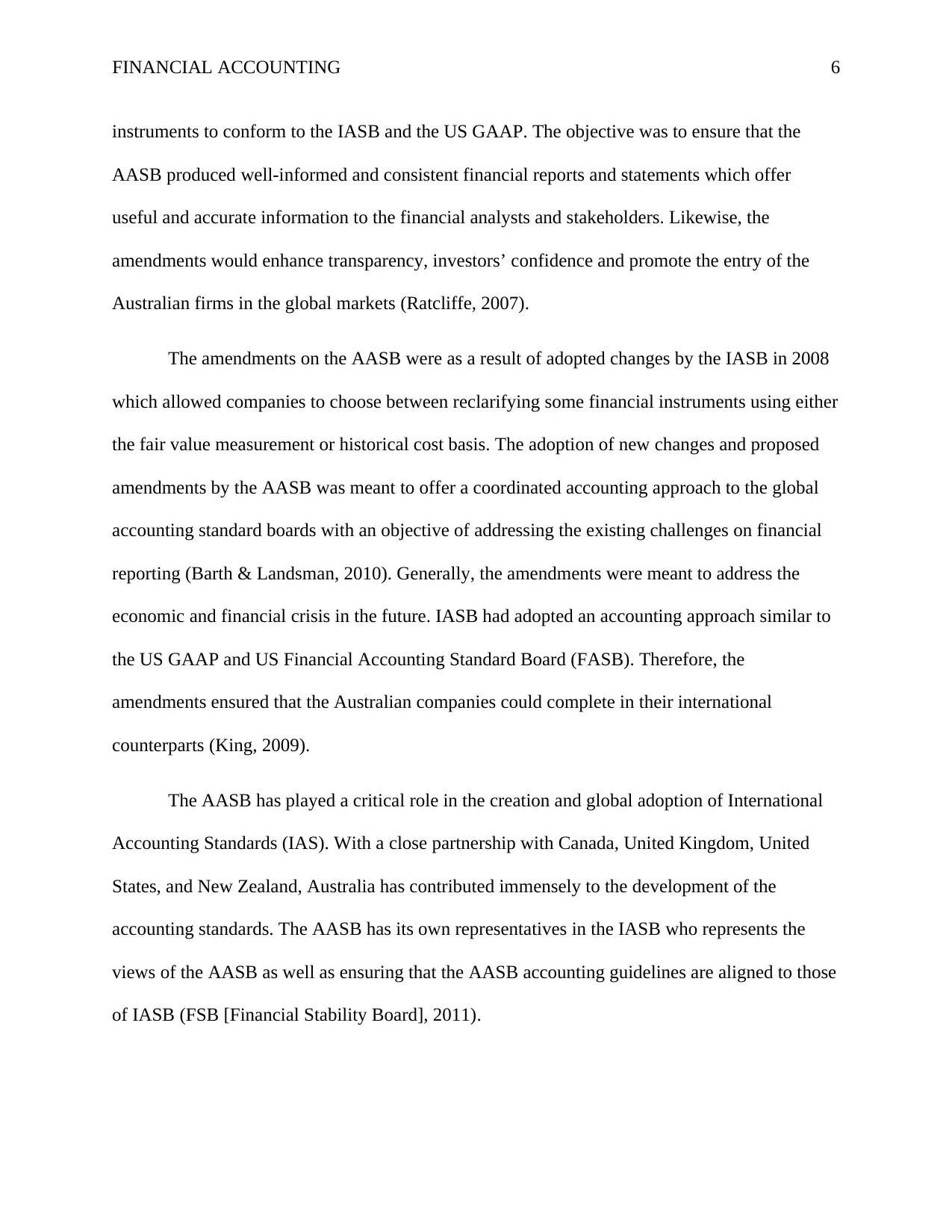
FINANCIAL ACCOUNTING 6
instruments to conform to the IASB and the US GAAP. The objective was to ensure that the
AASB produced well-informed and consistent financial reports and statements which offer
useful and accurate information to the financial analysts and stakeholders. Likewise, the
amendments would enhance transparency, investors’ confidence and promote the entry of the
Australian firms in the global markets (Ratcliffe, 2007).
The amendments on the AASB were as a result of adopted changes by the IASB in 2008
which allowed companies to choose between reclarifying some financial instruments using either
the fair value measurement or historical cost basis. The adoption of new changes and proposed
amendments by the AASB was meant to offer a coordinated accounting approach to the global
accounting standard boards with an objective of addressing the existing challenges on financial
reporting (Barth & Landsman, 2010). Generally, the amendments were meant to address the
economic and financial crisis in the future. IASB had adopted an accounting approach similar to
the US GAAP and US Financial Accounting Standard Board (FASB). Therefore, the
amendments ensured that the Australian companies could complete in their international
counterparts (King, 2009).
The AASB has played a critical role in the creation and global adoption of International
Accounting Standards (IAS). With a close partnership with Canada, United Kingdom, United
States, and New Zealand, Australia has contributed immensely to the development of the
accounting standards. The AASB has its own representatives in the IASB who represents the
views of the AASB as well as ensuring that the AASB accounting guidelines are aligned to those
of IASB (FSB [Financial Stability Board], 2011).
instruments to conform to the IASB and the US GAAP. The objective was to ensure that the
AASB produced well-informed and consistent financial reports and statements which offer
useful and accurate information to the financial analysts and stakeholders. Likewise, the
amendments would enhance transparency, investors’ confidence and promote the entry of the
Australian firms in the global markets (Ratcliffe, 2007).
The amendments on the AASB were as a result of adopted changes by the IASB in 2008
which allowed companies to choose between reclarifying some financial instruments using either
the fair value measurement or historical cost basis. The adoption of new changes and proposed
amendments by the AASB was meant to offer a coordinated accounting approach to the global
accounting standard boards with an objective of addressing the existing challenges on financial
reporting (Barth & Landsman, 2010). Generally, the amendments were meant to address the
economic and financial crisis in the future. IASB had adopted an accounting approach similar to
the US GAAP and US Financial Accounting Standard Board (FASB). Therefore, the
amendments ensured that the Australian companies could complete in their international
counterparts (King, 2009).
The AASB has played a critical role in the creation and global adoption of International
Accounting Standards (IAS). With a close partnership with Canada, United Kingdom, United
States, and New Zealand, Australia has contributed immensely to the development of the
accounting standards. The AASB has its own representatives in the IASB who represents the
views of the AASB as well as ensuring that the AASB accounting guidelines are aligned to those
of IASB (FSB [Financial Stability Board], 2011).
⊘ This is a preview!⊘
Do you want full access?
Subscribe today to unlock all pages.

Trusted by 1+ million students worldwide
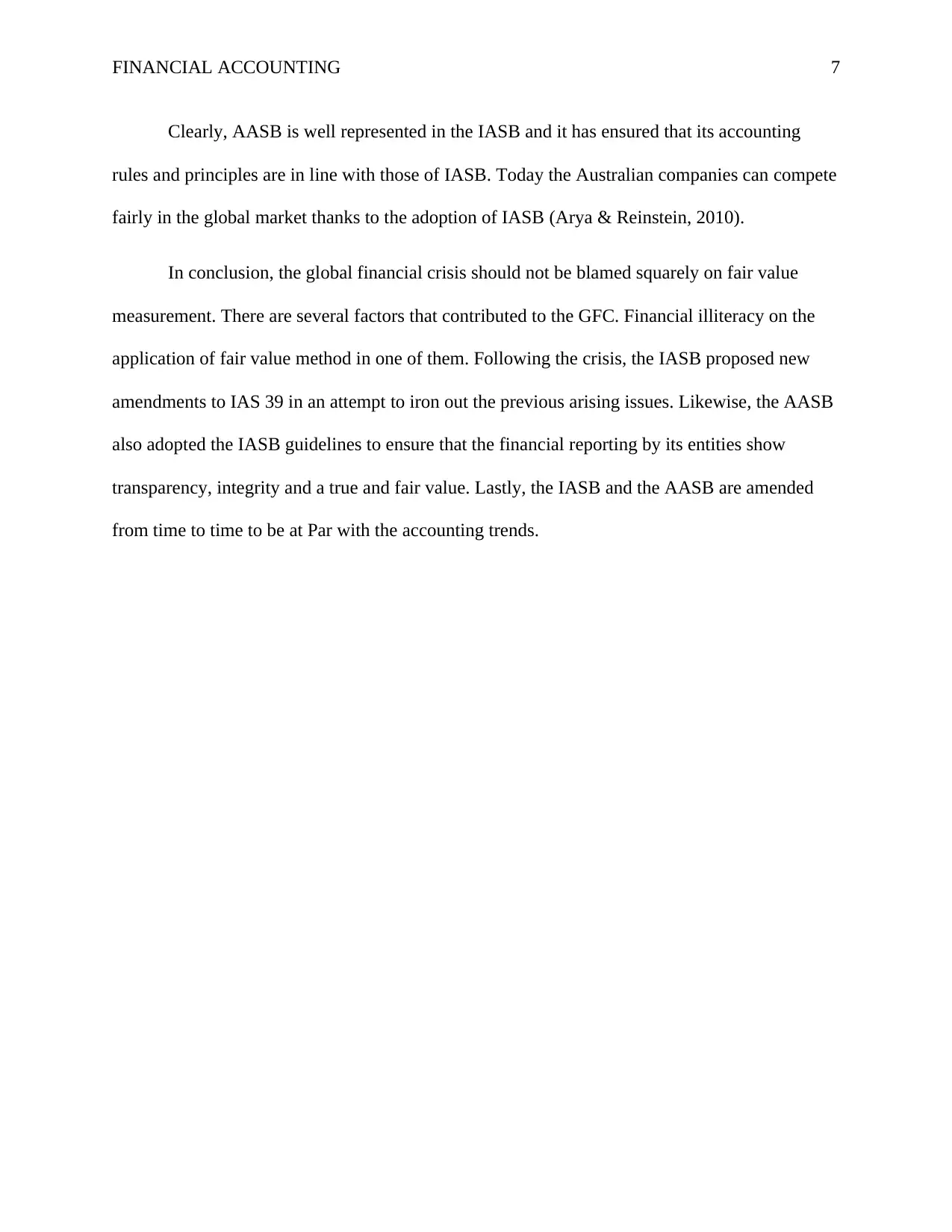
FINANCIAL ACCOUNTING 7
Clearly, AASB is well represented in the IASB and it has ensured that its accounting
rules and principles are in line with those of IASB. Today the Australian companies can compete
fairly in the global market thanks to the adoption of IASB (Arya & Reinstein, 2010).
In conclusion, the global financial crisis should not be blamed squarely on fair value
measurement. There are several factors that contributed to the GFC. Financial illiteracy on the
application of fair value method in one of them. Following the crisis, the IASB proposed new
amendments to IAS 39 in an attempt to iron out the previous arising issues. Likewise, the AASB
also adopted the IASB guidelines to ensure that the financial reporting by its entities show
transparency, integrity and a true and fair value. Lastly, the IASB and the AASB are amended
from time to time to be at Par with the accounting trends.
Clearly, AASB is well represented in the IASB and it has ensured that its accounting
rules and principles are in line with those of IASB. Today the Australian companies can compete
fairly in the global market thanks to the adoption of IASB (Arya & Reinstein, 2010).
In conclusion, the global financial crisis should not be blamed squarely on fair value
measurement. There are several factors that contributed to the GFC. Financial illiteracy on the
application of fair value method in one of them. Following the crisis, the IASB proposed new
amendments to IAS 39 in an attempt to iron out the previous arising issues. Likewise, the AASB
also adopted the IASB guidelines to ensure that the financial reporting by its entities show
transparency, integrity and a true and fair value. Lastly, the IASB and the AASB are amended
from time to time to be at Par with the accounting trends.
Paraphrase This Document
Need a fresh take? Get an instant paraphrase of this document with our AI Paraphraser
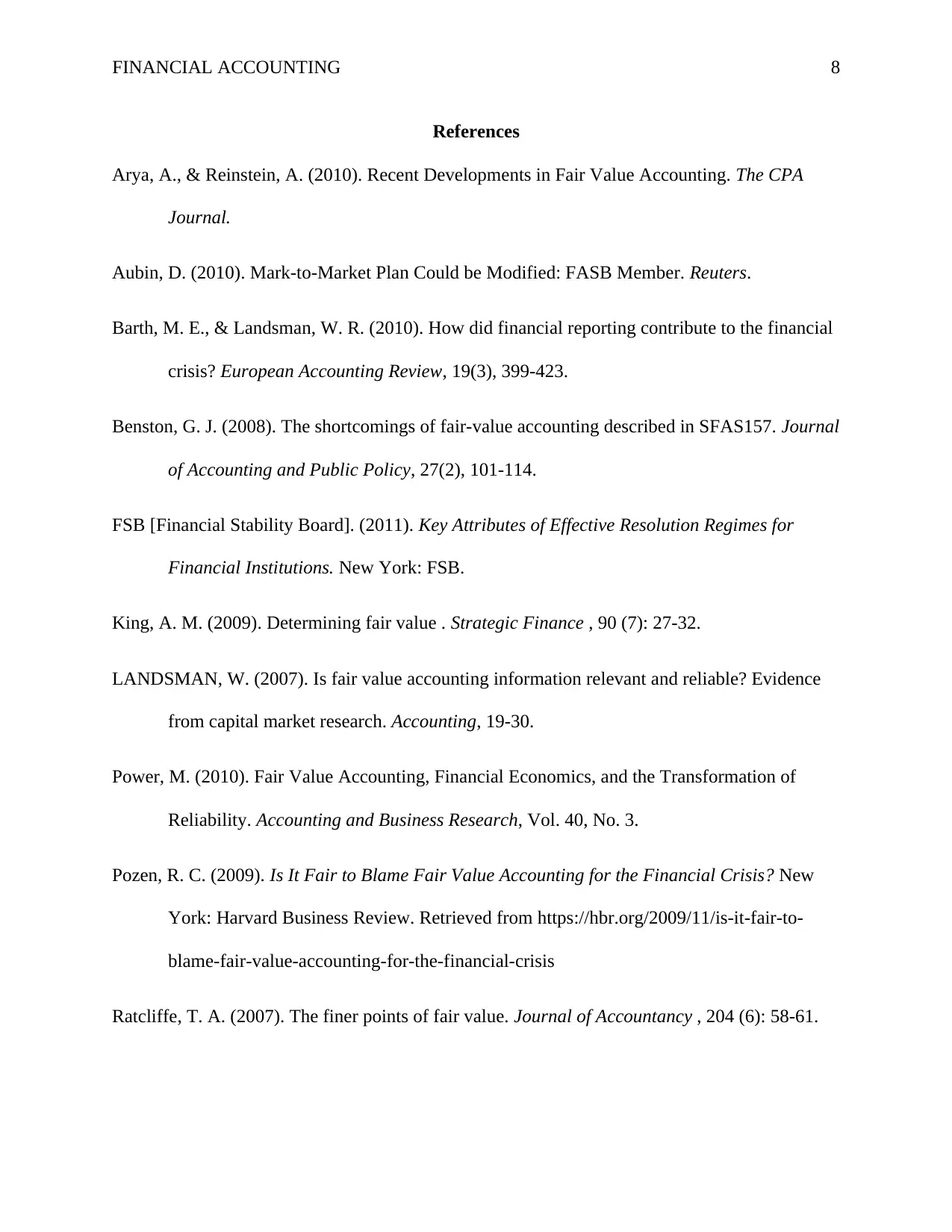
FINANCIAL ACCOUNTING 8
References
Arya, A., & Reinstein, A. (2010). Recent Developments in Fair Value Accounting. The CPA
Journal.
Aubin, D. (2010). Mark-to-Market Plan Could be Modified: FASB Member. Reuters.
Barth, M. E., & Landsman, W. R. (2010). How did financial reporting contribute to the financial
crisis? European Accounting Review, 19(3), 399-423.
Benston, G. J. (2008). The shortcomings of fair-value accounting described in SFAS157. Journal
of Accounting and Public Policy, 27(2), 101-114.
FSB [Financial Stability Board]. (2011). Key Attributes of Effective Resolution Regimes for
Financial Institutions. New York: FSB.
King, A. M. (2009). Determining fair value . Strategic Finance , 90 (7): 27-32.
LANDSMAN, W. (2007). Is fair value accounting information relevant and reliable? Evidence
from capital market research. Accounting, 19-30.
Power, M. (2010). Fair Value Accounting, Financial Economics, and the Transformation of
Reliability. Accounting and Business Research, Vol. 40, No. 3.
Pozen, R. C. (2009). Is It Fair to Blame Fair Value Accounting for the Financial Crisis? New
York: Harvard Business Review. Retrieved from https://hbr.org/2009/11/is-it-fair-to-
blame-fair-value-accounting-for-the-financial-crisis
Ratcliffe, T. A. (2007). The finer points of fair value. Journal of Accountancy , 204 (6): 58-61.
References
Arya, A., & Reinstein, A. (2010). Recent Developments in Fair Value Accounting. The CPA
Journal.
Aubin, D. (2010). Mark-to-Market Plan Could be Modified: FASB Member. Reuters.
Barth, M. E., & Landsman, W. R. (2010). How did financial reporting contribute to the financial
crisis? European Accounting Review, 19(3), 399-423.
Benston, G. J. (2008). The shortcomings of fair-value accounting described in SFAS157. Journal
of Accounting and Public Policy, 27(2), 101-114.
FSB [Financial Stability Board]. (2011). Key Attributes of Effective Resolution Regimes for
Financial Institutions. New York: FSB.
King, A. M. (2009). Determining fair value . Strategic Finance , 90 (7): 27-32.
LANDSMAN, W. (2007). Is fair value accounting information relevant and reliable? Evidence
from capital market research. Accounting, 19-30.
Power, M. (2010). Fair Value Accounting, Financial Economics, and the Transformation of
Reliability. Accounting and Business Research, Vol. 40, No. 3.
Pozen, R. C. (2009). Is It Fair to Blame Fair Value Accounting for the Financial Crisis? New
York: Harvard Business Review. Retrieved from https://hbr.org/2009/11/is-it-fair-to-
blame-fair-value-accounting-for-the-financial-crisis
Ratcliffe, T. A. (2007). The finer points of fair value. Journal of Accountancy , 204 (6): 58-61.
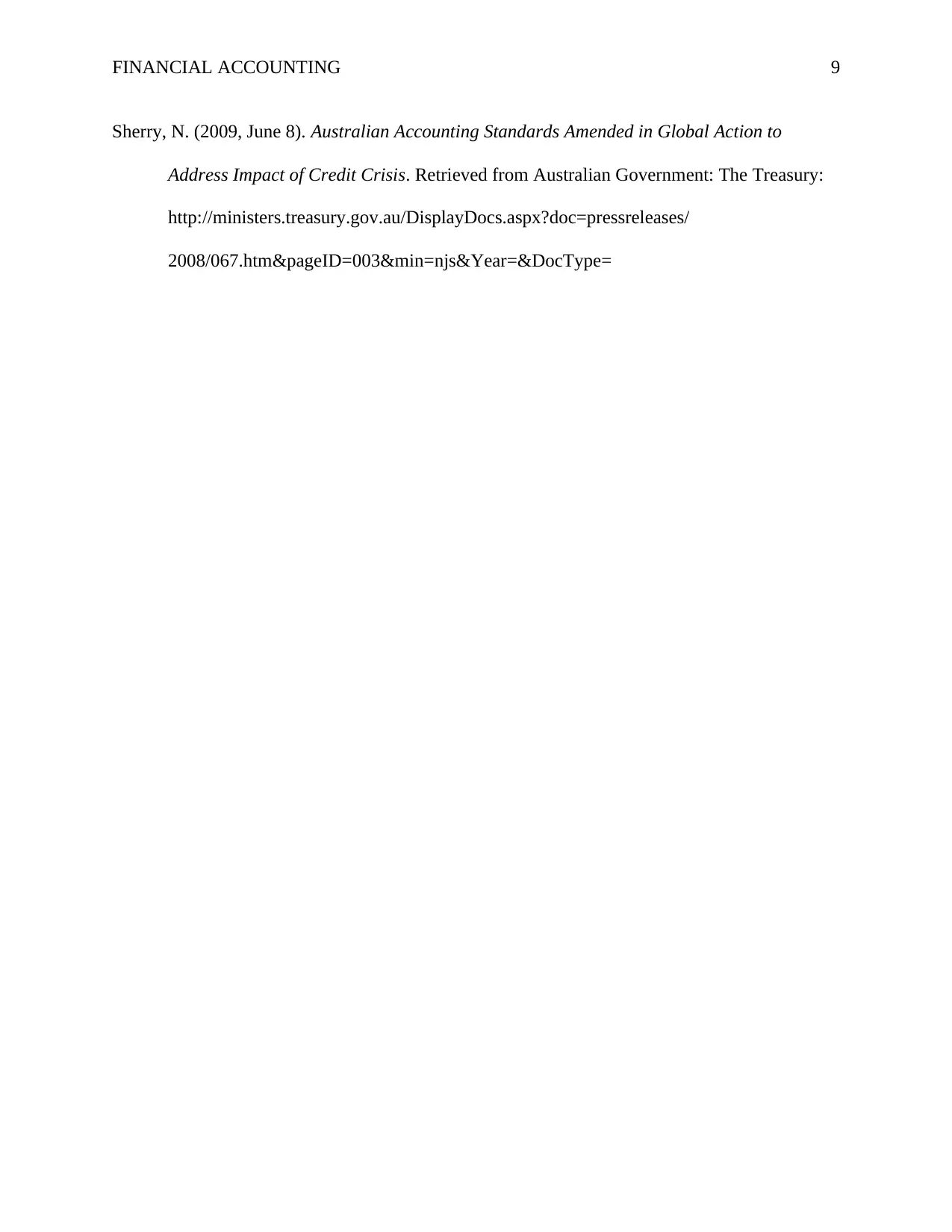
FINANCIAL ACCOUNTING 9
Sherry, N. (2009, June 8). Australian Accounting Standards Amended in Global Action to
Address Impact of Credit Crisis. Retrieved from Australian Government: The Treasury:
http://ministers.treasury.gov.au/DisplayDocs.aspx?doc=pressreleases/
2008/067.htm&pageID=003&min=njs&Year=&DocType=
Sherry, N. (2009, June 8). Australian Accounting Standards Amended in Global Action to
Address Impact of Credit Crisis. Retrieved from Australian Government: The Treasury:
http://ministers.treasury.gov.au/DisplayDocs.aspx?doc=pressreleases/
2008/067.htm&pageID=003&min=njs&Year=&DocType=
⊘ This is a preview!⊘
Do you want full access?
Subscribe today to unlock all pages.

Trusted by 1+ million students worldwide
1 out of 9
Related Documents
Your All-in-One AI-Powered Toolkit for Academic Success.
+13062052269
info@desklib.com
Available 24*7 on WhatsApp / Email
![[object Object]](/_next/static/media/star-bottom.7253800d.svg)
Unlock your academic potential
Copyright © 2020–2025 A2Z Services. All Rights Reserved. Developed and managed by ZUCOL.





